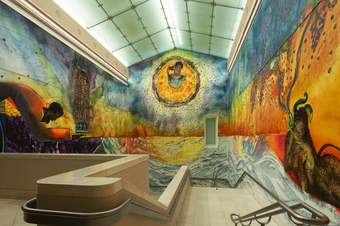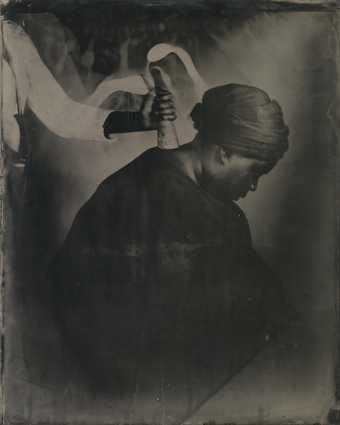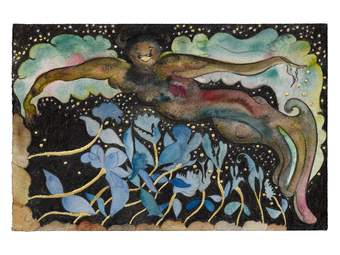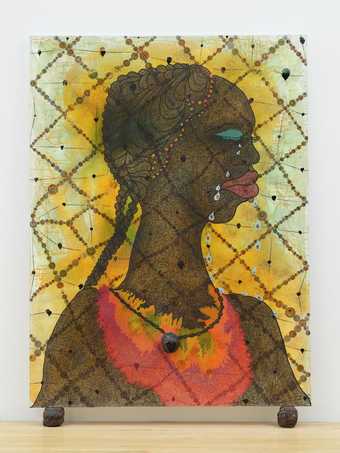Tate commissioned British artist Chris Ofili to create an artwork for the North Staircase at Tate Britain. Ofili considered the significance of painting directly onto the walls of a public building and wanted to choose a subject that affected us as a nation. Requiem is a dream-like mural, resulting from his poetic reflections.
Ofili met fellow artist Khadija Saye in May 2017 when they were both exhibiting in Venice. One month later, Saye died in the Grenfell Tower fire. Memories of their meeting had a profound impact on Ofili. It helped him find a path to create this work, which holds at its centre an image of Saye as a ‘powerful creative force of transformation.’
When making this artwork, Ofili recalled the feelings he had when he made No Woman, No Cry in 1998 (The work is on display in Room 26 at Tate Britain). No Woman, No Cry is a tribute to Stephen Lawrence and his mother, Doreen. Stephen was murdered in a racially motivated attack in 1993. For Ofili, ‘a statement of sadness was manifested in No Woman, No Cry. That feeling of injustice has returned.’
‘I wanted to make a work in tribute to Khadija Saye. Remembering the Grenfell Tower fire, I hope that the mural will continue to speak across time to our collective sadness.’
Listen to Chris Ofili talk about the work
The piece remembers the tragedy of Grenfell and the fire that occurred in June 2017 and pays tribute to Khadija Saye, an artist who lived in the tower and died there along with her mother, Mary Mendy.
I knew that I wanted to make a work that would say 'remember this'. And it needed to be direct in the way that it treated the subject matter. So I broke it down into three parts, three walls, three separate drawings that somehow would come together to read as one complete work.
I conceive of the bowing figure on the left, which is the first chapter of the mural as a witness, and he is presenting Grenfell Tower burning with the reverence of someone that’s conducting a ceremony of loss or a Requiem. Carefully and with respect and with emotion, which is released in his tears falling into a river or an ocean that's accumulating below him of despair. I see it as a tender, trembling, respectful and dutiful act that he's performing. And from there I visualised the spirits of souls that move away from the tower and escaping.
The second chapter of the mural focuses on portraying Khadija Saye who's the artist that I met and who was killed in in Grenfell Tower. And this image is taken directly from one of her self-portraits that Khadija was exhibiting in Venice in the Diaspora Pavilion at the same time that I met her in 2017.
I was coming back from a trip to Venice after doing another exhibition there and we passed the remains of the Grenfell Tower wrapped. And it wasn't the first time that I'd seen it, but before I always found that I always looked away instinctively quite soon after looking at it. But this time I became quite self-conscious of that so I decided that I was going to continue looking. And my memories of first meeting Khadija in Venice in 2017, shortly before she was killed in the fire in June, came flooding back in and started to crystallise into my thoughts. And you know, these thoughts of like just utter discomfort, almost physical feelings of looking at something and being reminded of something that was really, really terrible. All those feelings started to surface in my mind and I felt that the luxury of being able to indulge at looking at something, then being able to look away - that luxury was no longer tenable. That I actually had to start to face up to that discomfort.
So I would say it was precisely in those moments of looking that the subject matter of the mural fell into place. I felt that I could grab on to the idea that the mural could reflect what had happened in Grenfell. But it did make me realise that in order for something like that to never happen again, we have to be reminded that it did.
Public art can hold spaces of grief and it can keep alive collective memories of events that might otherwise completely just fade away in time, just as life inevitably moves on.
So the body of water which flows across the entire mural is a way of linking Venice and London and a way of symbolising the shared connection I had with Khadija and somehow is trying to honour this brief meeting and the power or energy or charisma that I felt about her and unfortunately now has just become an emotional memory for me, and I suppose a kind of collective grief around her loss as an individual and as an artist. In the self-portrait she's holding a vessel up to her ear. And it's a Gambian incense pot, which is traditionally used to drive away evil spirits from the home. And it's a precious object that honours her dual faith heritage of Christianity and Islam. And I suppose because of that it's charged with personal meaning.
In the central section the spirits of souls kind of come together as an energy force. And they’re drawn to and converge around this source of radiance or magnetism with Khadija's image at its centre.
So moving then into the third chapter of the mural, you see the spirit of souls drawn towards a more Edenic landscape of hope, redemption, and hopefully extraordinary peace. And you see the colours of the burning tower are transformed into those of a warm sunrise or sunset. And all the way on the right-hand side there's a purple tree and this manifold spirit of souls start to converge and settle in and around this flowering tree-like shrub which is based on a plant called the cyanothus which grows in a garden that is dedicated to Khadija's memory. And then underneath the tree you've got this singular - but in my imagination, I imagine many – mythical faun-like creatures lying and resting in the shade of that tree playing music. And that sound or that melody drifting across the water and the horizon, almost calling the spirit of souls into a place of peace.
When I talk about the piece now and picture it and look at it, I feel that an important part is this horizon that runs all the way across. And it's a device, I suppose, an artistic device, to create a boundary that divides the sky from the water, but also separates the earth and, I would say, realms beyond earth. And as a whole, I intended the mural to invite reflection on loss, spirituality and transformation. And particularly these elements are important to me today in 2023, as we are waiting for the final report of the Grenfell inquiry to be published and campaigners fight for its Phase one recommendations to be implemented. And as the criminal investigation into the fire's deadly spread is still ongoing.
I think I hope that the fact that it's painted directly on the walls of a public museum will allow it to speak across time in a very direct way. And I think it's important that in some ways that this work isn't something that's transportable. And the impact of the life of it on the walls will remain and will pass through people's minds and memories. And I’ve had to go through, and the different waves of emotions that I've gone through in researching and putting the image together were sometimes extremely tearful and very difficult and contradictory and I wouldn't really discount any reaction that anyone might have to the mural. But I do hope that it will give the viewer an opportunity to really look and feel and be aware of their emotional responses – anger, sadness and any other emotion is valid and relevant. Emotions change and opinions change over time, but this work will stay the same. And I hope that it prompts a collective paying attention of a devastating historical event.
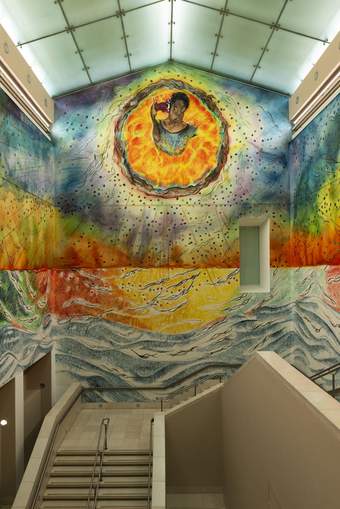
Chris Ofili, Requiem, 2023 (detail), commissioned for Tate Britain’s north staircase. © Chris Ofili. Courtesy the artist. Photograph: Thierry Bal
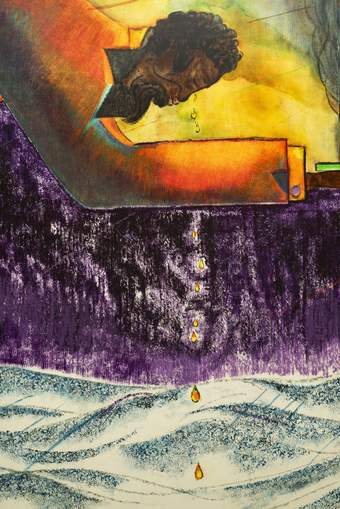
Chris Ofili, Requiem, 2023 (detail), commissioned for Tate Britain’s north staircase. © Chris Ofili. Courtesy the artist. Photograph: Thierry Bal

Chris Ofili, Requiem, 2023 (detail), commissioned for Tate Britain’s north staircase. © Chris Ofili. Courtesy the artist. Photograph: Thierry Bal

Chris Ofili, Requiem, 2023 (detail), commissioned for Tate Britain’s north staircase. © Chris Ofili. Courtesy the artist. Photograph: Thierry Bal
Requiem has been supported by the Chris Ofili Commission Supporters Circle: Andreas & Ulrike Kurtz, Victoria Miro, David Zwirner and all those who wish to remain anonymous
This project has been made possible with the support of Nicola Green and the Estate of Khadija Saye
Chris Ofili’s mural unfolds in three chapters over Tate Britain’s North Staircase. This commentary is drawn from the artist’s reflections:
Chapter 1: Look. Look at this. Look at what we’ve done. Look at what is happening
The bowing figure on the left-hand wall at the top of the staircase is a prophet or witness. He presents the burning tower to us, as though conducting a ceremony of loss or a requiem. Confronted by the overwhelming tragedy of what has happened, his tears fall into a great ocean of despair. Here, Ofili traces the path of souls escaping desperate peril, moving through embers or plunging into the water, then circling around and away from the tower.
Chapter 2: Change and transformation
Artist Khadija Saye is at the centre of an energy force, high up on the middle wall. She represents one of the souls. She holds an andichurai (a Gambian incense pot) to her ear, in a pose taken from her own artwork. This object was precious to Saye, as it belonged to her mother. It symbolises the possibility of transformation through faith, honouring Saye’s dual faith heritage of Christianity and Islam. Ofili invites us to imagine the sound of calm solace here – perhaps like the call of the ocean you hear when holding a shell to your ear.
Chapter 3: A place for redemption, healing and hope
To the right, the spirit of the souls emerges from the water and sky to arrive in a paradise-like landscape, resting by the banks of the water under the shade of a beautiful branching tree. Two mythical beings play a sweet, hopeful melody on their instruments. The energy of the souls is drawn to this realm of extraordinary peace. The colours of the burning tower turn into a warm sunrise or sunset. The water contains our collective grief in the flow of tears. It also links to Venice, where Ofili and Saye met. The water connects London to Ofili’s home in Trinidad.
Khadija Saye (1992–2017) was an artist and activist. At the time of her death, Saye had established herself as an emerging talent with extraordinary promise for the future.
A reproduction of Khadija Saye’s work, Andichurai, from the series Dwelling: in this space we breathe 2017, is on display at Tate Britain. Ofili drew inspiration for his own work from this image.
Saye was an advocate for greater diversity in the arts. She said, ‘If you don’t see yourself represented then you don’t think you can do it. It’s the idea of opening the door for the next generation’.
Khadija Saye Arts at IntoUniversity has been set up in her memory.
On 14 June 2017, a devastating fire broke out at Grenfell Tower in west London, killing 72 people, including 18 children. It was the greatest loss of life in a residential fire since the Second World War.
A Public Inquiry was set up in the wake of the fire. It found that the tower’s exterior cladding failed to meet safety standards, making the fire spread more quickly and leading to many avoidable deaths. This prompted wider concerns about building safety in high-rise blocks across the country and highlighted significant social inequality in one of the wealthiest parts of London.
Systemic failures across the organisations responsible for building standards and safety were found to have contributed to this preventable tragedy: from the construction industry to regulators, the architects, the fire service, the local authority, and the government, which has formally apologised.
The deadly effects of the blaze, the toxic smoke and the obstacles to escape have been a consistent feature of survivors’ testimony. The bravery of those who endured the fire that night and the strength of the local community response have been recognised.
The Public Inquiry concluded in September 2024 that the deaths that occurred were all avoidable. Its official report contained 58 recommendations to prevent another tragedy of this nature happening again. In his response, the Prime Minister said, ‘The country had failed to discharge its most fundamental duty to protect.’ He stated, ‘There must now be full accountability.’
Survivors and bereaved families from the Grenfell Tower fire continue their campaign, insisting that ‘people should face justice’.
The criminal investigation into the cause of the fire is ongoing.
Tate Britain's step-free entrance is on Atterbury Street. It has automatic sliding doors and there is a ramp down to the entrance with central handrails.
The artwork is located on the North Stairs, near the step-free entrance on Atterbury Street.
There is a lift between the Lower and Main floors near the staircase. Alternatively you can take the stairs. There are 37 steps. On the Lower floor, the staircase is accessible via an open entrance-way.
The artwork can be viewed from both the top of the staircase (on the Main floor) and the bottom of the staircase (on the Lower floor), although it is recommended to view from the top.
On exiting the lift on the Main floor, the staircase is accessible via power-assisted double doors. Through the doors there is a walled viewing area adjacent to the steps.
Large print text and printed visuals of the artwork are available to borrow.
